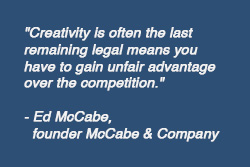Effective Marketing Takes Creative Risk
“Safe advertising is the riskiest advertising you can do.”
– Bill Bernbach, Co-founder, BBD Advertising Agency
 Creativity is what sells, and being creative means taking risks.
Creativity is what sells, and being creative means taking risks.In my book, Branding Insights for Small Business, I point out that creativity is marketing’s most underutilized tool. An ad, brochure or website is just a delivery method for a sales message – it’s the creativity in that message that most determines how effectively it performs!
It’s an easy fact to forget in today’s technology-rich environment, where data dominates most marketing conversations. The right data can help a small business level the playing field against larger competitors when it comes to reaching the right audience at the right time. But tipping the scales in your favor requires getting your customers’ attention with a unique and memorable idea.
T. Taylor, founder of The Creative Alliance, agrees: “Instead of taking a potentially bigger creative risk, too many [businesses] settle for safety and taking the route most traveled.” He thinks what many business leaders lack is creative courage – the willingness to put themselves out there. “I like the questions, ‘What if?’ and ‘Why not?’ when thinking of new ways to do things,” he says. “Everything is possible when you have creative courage.”
Champion Creativity and Risk
Recall the last ad that caught your attention. What was it that made it stand out? Was it funny? Beautifully designed? Did it make you look at the product or service in a new way?
With the glut of advertising and marketing that saturates our daily lives, your message must capture your customer’s attention – it doesn’t need to win awards, but it should strive to amuse, captivate, tell a story or provoke thought.
Why is so much advertising so formulaic and uninspired? Because many large companies tend to be conservative and a “cover your ass” mindset prevails with many marketing and product managers. It’s better, they reason, not to stick their neck out too far (and possibly lose it) with a risky new idea that might fail. Smaller businesses tend to follow suit, mimicking what their larger competitors are doing.
Then, when a competitor comes along with a bold, new creative idea, the “me-too” marketers break out it in a sweat as they hustle to catch up.
Thinking Creatively
What does a truly creative idea look like? Don’t look to what’s been done before, except for inspiration – look to what will surprise and delight your customers.

Try to approach every new marketing idea with the same blank slate your customers will bring to it. They don’t know a thing about your strategy or your positioning. They’ll be ready to move on in seconds if you don’t grab their attention.
So be cognizant of your first impression. Don’t over-evaluate a creative idea or you’ll start to second-guess its effectiveness. The same thing happens when ideas are passed around between departments for input and approval. You just can’t make creative decisions by committee. Before you know it a great idea gets pushed aside in favor of the consensus winner – usually the safer and least effective choice.
Go For The Big Idea
In his book Ogilvy on Advertising, legendary ad man David Ogilvy suggests asking the following questions to spot a big idea:
- Did it make me gasp when I first saw it?
- Do I wish I had thought of it myself?
- Is it unique?
- Does it fit the strategy to perfection?
- Could it be used for 30 years?
Big ideas are simple and easy to understand. They’re easily adapted to different campaigns, media and tactics, and they can be implemented with various creative ideas and executions.

Take Nike, for example. Its big idea? They saw the fitness trend exploding in the late 1980s, but also understood that not everyone was going to run a marathon. (At the time Nike marketed exclusively to marathon runners.) Their “Just Do It” campaign was short and sweet, yet encapsulated everything people felt about exercising. Don’t feel like running today? Just Do It. Don’t feel like taking the stairs instead of the elevator? Just Do It. And that feeling remains the same today, which is why the campaign was so successful.
Exercise your creative courage and think big if you want to stand out. Push the creative envelope, and you’re more likely to come up with something that has a real impact. Remember what another advertising legend, Leo Burnett, suggests: “When you reach for the stars, you may not quite get one, but you won’t come up with a handful of mud either.”